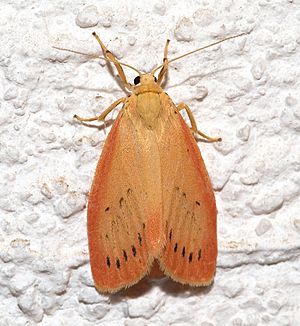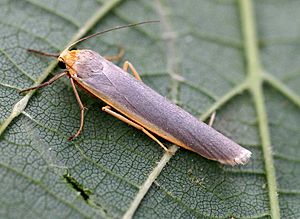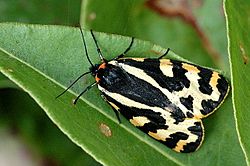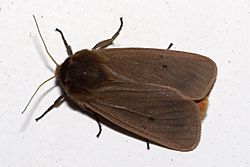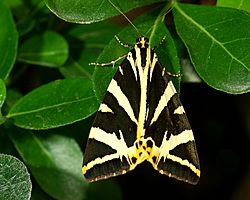List of moths of Great Britain (Arctiinae) facts for kids
The subfamily Arctiinae is a group of moths often called tiger moths, ermines, and "footmen." These moths are known for their bright colors and interesting patterns. In Great Britain, you can find 32 different species of these fascinating insects.
Contents
Meet the Footman Moths: Tribe Lithosiini
This group of moths is commonly known as "footmen" because of how they rest. They often fold their wings tightly around their bodies, making them look like a small, rolled-up stick or a tiny log. Many of them have slender bodies and narrow wings.
- Thumatha senex, round-winged muslin – Found in the south, central, and northern parts of Britain, but only in certain areas.
- Setina irrorella, dew moth – Lives in the south and north-west. It's considered a Nationally Scarce A species, meaning it's rare and found in fewer than 16 locations.
- Miltochrista miniata, rosy footman – Found in the south and central regions, also in specific spots.
- Nudaria mundana, muslin footman – Can be found all over Britain, but only in certain places.
- Atolmis rubricollis, red-necked footman – Lives in the south, west-central, and north, in specific areas.
- Cybosia mesomella, four-dotted footman – Found throughout Britain, but in specific spots.
- Pelosia muscerda, dotted footman – Lives in the east. This moth is listed in the Red Data Book, which means it's very rare and needs protection.
- Pelosia obtusa, small dotted footman – Also found in the east and listed in the Red Data Book.
- Eilema sororcula, orange footman – Found in the south, in specific areas.
- Eilema griseola, dingy footman – Lives in the south and central parts of Britain.
- Eilema caniola, hoary footman – Found in the south-west. It's a Nationally Scarce B species, meaning it's rare and found in 16 to 100 locations.
- Eilema pygmaeola, pygmy footman – This tiny moth is also in the Red Data Book.
- Eilema pygmaeola pygmaeola – Found in the east.
- Eilema pygmaeola pallifrons – Lives in the south-east.
- Eilema complana, scarce footman – Found in the south and central regions, in specific areas.
- Eilema complana f. sericea, northern footman – Lives in west-central Britain and is in the Red Data Book.
- Eilema depressa, buff footman – Found in the south and central parts, in specific areas.
- Eilema lurideola, common footman – Can be found in the south, central, and northern parts of Britain.
- Lithosia quadra, four-spotted footman – This moth is an immigrant to the south-west, meaning it flies over from other countries. It's a Nationally Scarce A species.
Tiger and Ermine Moths: Tribe Arctiini
This group includes some of the most colorful and well-known moths, like the tiger moths with their bold patterns and the ermine moths, which are often white or pale with spots.
- Coscinia cribraria, speckled footman – This species is part of the UK Biodiversity Action Plan (BAP), which means there are efforts to protect it.
- Coscinia cribraria bivittata – Found in the south and is a Red Data Species, meaning it's very rare and protected.
- Coscinia cribraria arenaria – An immigrant species.
- Utetheisa pulchella, crimson speckled – Another immigrant moth.
- Parasemia plantaginis, wood tiger – A beautiful moth.
- Arctia caja, garden tiger – Found throughout Britain. This species is also part of the UK BAP and is studied for research.
- Arctia villica britannica, cream-spot tiger – Lives in the south, in specific areas.
- Diacrisia sannio, clouded buff – Found throughout Britain, but only in certain spots.
- Spilosoma lubricipeda, white ermine – Found throughout Britain. It's part of the UK BAP and studied for research.
- Spilosoma luteum, buff ermine – Lives in the south, central, and northern parts of Britain. Also part of the UK BAP and studied for research.
- Spilosoma urticae, water ermine – Found in the south-east. It's a Nationally Scarce B species.
- Diaphora mendica, muslin moth – Lives in the south, central, and northern parts of Britain.
- Phragmatobia fuliginosa, ruby tiger – A lovely red moth.
-
- Phragmatobia fuliginosa borealis – Found in the north.
- Phragmatobia fuliginosa fuliginosa – Lives in the south and central parts.
- Euplagia quadripunctaria, Jersey tiger – Found in the south-west.
- Callimorpha dominula, scarlet tiger – Lives in the south-west, in specific areas.
- Tyria jacobaeae, cinnabar – Found in the south, central, and northern parts of Britain. This moth is part of the UK BAP and studied for research.
Protecting Moths: The UK Biodiversity Action Plan
Some of the moths listed above have a special symbol (‡) next to their names. This means they are included in the 2007 UK Biodiversity Action Plan (BAP). The BAP is a plan to help protect and increase the number of rare or threatened species in the UK. If you see a double-dagger with an asterisk (‡*), it means the species is listed in the BAP for research purposes, so scientists can learn more about them and how to help them.
See also
- List of moths of Great Britain (overview)
- Family lists: Hepialidae, Cossidae, Zygaenidae, Limacodidae, Sesiidae, Lasiocampidae, Saturniidae, Endromidae, Drepanidae, Thyatiridae, Geometridae, Sphingidae, Notodontidae, Thaumetopoeidae, Lymantriidae, Arctiidae, Ctenuchidae, Nolidae, Noctuidae and Micromoths


